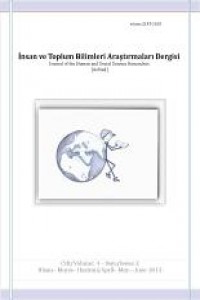Abstract
China has implemented various policies during different periods of history, due to its relationships with the neighbouring nations and with the powers within. It is observed that especially during Han Dynasty (206 BC - 220 AD), there were abundant relations with other nations. One of the most important policies of Han Dynasty is the hostage system. The hostage is a tool to protect national relations, to establish temporary peace, or simply to achieve a political goal. As it is with all policies, mutual benefit is an important component of the hostage system. The hostage system was used systematically during Han dynasty and could establish temporary peace at times, but it also brought serious harm when carried out in the wrong way. In this paper the hostage system in Han Dynasty is studied regarding why and how it was implemented as well as its effects on economy, politics, military, and culture.
References
- Bai, Shou Yi, An Outline History of China, Foreign Languages Press, Beijing, 2010.
- Chen, Jin Sheng, Han Xiong Zhi Zi Guan Xi Ji Qi Zuo Yong Shu Ping 汉匈质子关系及其作用述评 (Han-Çin Rehin İlişkisi ve Rolü Üzerine İnceleme) , Gan Su Lian He Da Xue Xue Bao, 25/3, 2009.
- Chen, Jin Sheng, Shi Lun Zhi Zi Zai Jia Qiang Zong Fan Guan Xi Zhong De Zuo Yong 史论质子在加强宗番关系中的作用 (Devlet İlişkilerini Güçlendirmede Rehinin Etkisi Üzerine), Gan Su Lian He Da Xue Xue Bao, 26/6, 2010.
- Cheng, Lin, Xi Han Shi Qi Min Zu Guan Xi Zhong De “Zhi Zi” Xian Xiang 西汉时期民族关系中的“质子”现象 (Batı Han Dönemi Ulus İlişkilerinde “Rehin” Olgusu), Xinjiang Üniversitesi Dergisi, 2007.
- Fairbank, John K. Twitchett Dennis, “The Cambridge History of China”, Volume I. The Ch’in and Han Empires, Cambridge University Press, 2008.
- Grand, Hardy-Kinney, Anne Behnke, “The Establishment of the Han Empire and Imparial China”, Greenwood Press, 2005.
- Li, Wen Ying, Liang Han Zhizi Zhidu de Yingxiang he Zuoyong Ping Shu 两汉质子制度的影响和作用评述 (Han Dönemi Rehin Sisteminin Etki ve Rollerinin İncelenmesi), 2010.
- Türker, Nurcan, “Han Hanedanlığı Döneminde Hunlarla Yürütülen Heqin (Akrabalık Yoluyla Barış Sağlama) Politikası ve Sonuçları” Ankara Üniversitesi, Sosyal Bilimler Enstitüsü (yayınlanmamış doktora tezi), Ankara, 2013.
- Xu, Jia Lu, “Er Shi Si Shi Quan Shi 二十四史全译 (Açıklamalı 24 Tarih)” Shi Ji, Juan 110, Lie Zhuan 50, Xiong Nu Lie Zhuan, Han Shu 94, Lie Zhuan 64, Xiong Nu Zhuan, Hou Han Shu 119, Lie Zhuan 79, Nan Xiong Nu Zhuan, Han Yu Da Ci Dian Chu Ban She, Shang Hai, 2004.
- Yang, Lien-Sheng, “Hostages in Chinese History”, Harvard Journal of Asiatic Studies, Vol.15No.3/4, Harvard-Yenching Institute, 1952.
- Zhang, Hu Ling, Liang Han Shiqi Zhizi Zhidu de Shidai Tese 两汉时期质子制度的时代特色 (Han Dönemi Rehin Sisteminin Dönemsel Özellikleri), Huaxia Wenhua, 2009.
- Kaynakça / Reference
- MLA veya APA kaynakça sistemine göre kaynaklar belirtilir.
- MLA veya APA kaynakça sistemine göre kaynaklar belirtilir.
Abstract
Çin tarih boyunca komşu uluslarla ve kendi içindeki diğer güçlerle olan ilişkileri gereği farklı dönemlerde farklı politikalar uygulamıştır. Özellikle Han Hanedanlığı döneminde (M.Ö. 206 - M.S.220) dış devletlerle ilişkilerin oldukça fazla olduğu görülmektedir. Hanedanlığın uyguladığı politikaların en önemlilerinden biri rehin sistemidir.[1] Rehin, ulus ilişkilerini korumak, geçici barış sağlamak, herhangi bir siyasi amaca ulaşmak için kullanılan bir araçtır. Tüm politikalarda olduğu gibi rehin sisteminde de karşılıklı çıkar söz konusudur. Rehin sistemi, Han Hanedanlığı döneminde sistemli bir şekilde kullanılmış, geçici süreyle barış sağlayabilmiş, ancak uygulama hatası yapıldığında büyük zararlar getirmiştir. Bu çalışmada rehin sisteminin ne amaçla ve nasıl uygulandığına, ekonomik, siyasi, askeri ve kültürel alanda etkilerine değinilmiştir.
[1] Gönderen ya da kabul eden taraf a göre değişiklik gösterdiğinden “Rehin gönderme veya kabul etme” yerine metnin içinde “rehin sistemi” kullanılmıştır. Çin genellikle rehini kabul eden taraftır.
References
- Bai, Shou Yi, An Outline History of China, Foreign Languages Press, Beijing, 2010.
- Chen, Jin Sheng, Han Xiong Zhi Zi Guan Xi Ji Qi Zuo Yong Shu Ping 汉匈质子关系及其作用述评 (Han-Çin Rehin İlişkisi ve Rolü Üzerine İnceleme) , Gan Su Lian He Da Xue Xue Bao, 25/3, 2009.
- Chen, Jin Sheng, Shi Lun Zhi Zi Zai Jia Qiang Zong Fan Guan Xi Zhong De Zuo Yong 史论质子在加强宗番关系中的作用 (Devlet İlişkilerini Güçlendirmede Rehinin Etkisi Üzerine), Gan Su Lian He Da Xue Xue Bao, 26/6, 2010.
- Cheng, Lin, Xi Han Shi Qi Min Zu Guan Xi Zhong De “Zhi Zi” Xian Xiang 西汉时期民族关系中的“质子”现象 (Batı Han Dönemi Ulus İlişkilerinde “Rehin” Olgusu), Xinjiang Üniversitesi Dergisi, 2007.
- Fairbank, John K. Twitchett Dennis, “The Cambridge History of China”, Volume I. The Ch’in and Han Empires, Cambridge University Press, 2008.
- Grand, Hardy-Kinney, Anne Behnke, “The Establishment of the Han Empire and Imparial China”, Greenwood Press, 2005.
- Li, Wen Ying, Liang Han Zhizi Zhidu de Yingxiang he Zuoyong Ping Shu 两汉质子制度的影响和作用评述 (Han Dönemi Rehin Sisteminin Etki ve Rollerinin İncelenmesi), 2010.
- Türker, Nurcan, “Han Hanedanlığı Döneminde Hunlarla Yürütülen Heqin (Akrabalık Yoluyla Barış Sağlama) Politikası ve Sonuçları” Ankara Üniversitesi, Sosyal Bilimler Enstitüsü (yayınlanmamış doktora tezi), Ankara, 2013.
- Xu, Jia Lu, “Er Shi Si Shi Quan Shi 二十四史全译 (Açıklamalı 24 Tarih)” Shi Ji, Juan 110, Lie Zhuan 50, Xiong Nu Lie Zhuan, Han Shu 94, Lie Zhuan 64, Xiong Nu Zhuan, Hou Han Shu 119, Lie Zhuan 79, Nan Xiong Nu Zhuan, Han Yu Da Ci Dian Chu Ban She, Shang Hai, 2004.
- Yang, Lien-Sheng, “Hostages in Chinese History”, Harvard Journal of Asiatic Studies, Vol.15No.3/4, Harvard-Yenching Institute, 1952.
- Zhang, Hu Ling, Liang Han Shiqi Zhizi Zhidu de Shidai Tese 两汉时期质子制度的时代特色 (Han Dönemi Rehin Sisteminin Dönemsel Özellikleri), Huaxia Wenhua, 2009.
- Kaynakça / Reference
- MLA veya APA kaynakça sistemine göre kaynaklar belirtilir.
- MLA veya APA kaynakça sistemine göre kaynaklar belirtilir.
Details
| Primary Language | Turkish |
|---|---|
| Journal Section | Articles |
| Authors | |
| Publication Date | February 10, 2015 |
| Published in Issue | Year 2015 Volume: 4 Issue: 2 |


